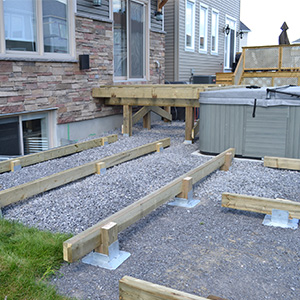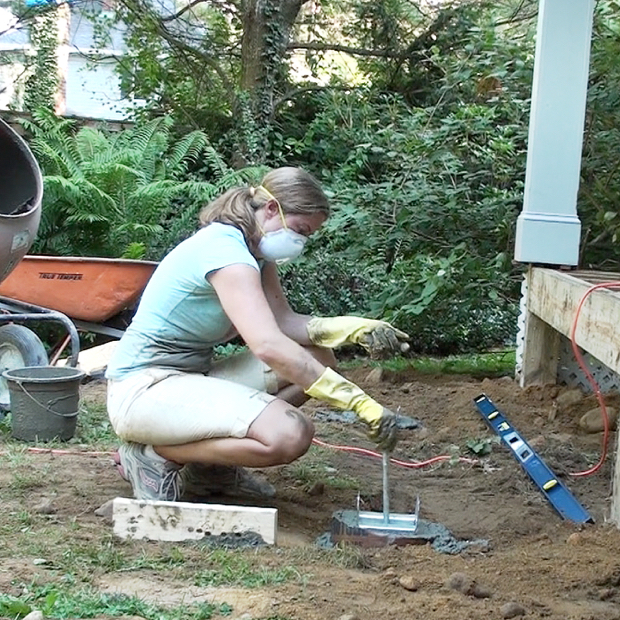Specialist Tips for Setting Up Deck Footings to Assistance Your Outdoor Area
When it pertains to building a deck, among one of the most crucial components to take into consideration is the installation of proper footings. These grounds are the structure whereupon your outside area will relax, supplying security and assistance for many years to find. However exactly what does it require to install deck footings appropriately? In this discussion, we will certainly discover expert suggestions and strategies that can assist guarantee a effective and resilient deck setup. From selecting the best kind of grounds to preventing usual blunders, we will certainly provide you with the expertise and understandings you require to confidently begin on your deck-building trip. So, allow's dive right in and discover the key to a solid and long-lasting outdoor space.
Importance of Proper Deck Grounds
Correct deck footings are necessary for ensuring the security and durability of your outdoor room. Without strong and effectively set up footings, your deck may become unsteady, leading to safety threats and expensive fixings.

Along with security, appropriate deck footings additionally add to the longevity of your outdoor space (Deck Footings). Grounds that are created and constructed to endure the aspects and dirt conditions in your area will help protect against the deck from working out or changing gradually. By guaranteeing the footings are appropriately sized and installed, you can decrease the danger of damages to the deck structure, expanding its life-span and minimizing the need for pricey repair work or substitutes

Selecting the Right Kind Of Grounds
When choosing the ideal kind of grounds for your deck, it is essential to take into consideration variables such as dirt problems, neighborhood building regulations, and the general style of your outside space. The kind of footing you choose will certainly play a crucial duty in making certain the security and durability of your deck.
One typical type of footing is the concrete ground. Concrete footings are appropriate for many dirt conditions and provide excellent assistance for decks.
In some instances, you might require to use customized grounds, such as heap footings or deep structures, if you are building a large or multi-level deck. These grounds are created to distribute the weight of the deck over a bigger location, ensuring security and protecting against sinking or working out.
Prior to picking a sort of ground, it is vital to seek advice from local building codes and laws to guarantee compliance. Furthermore, think about the style and planned use your exterior space. Variables such as the size, shape, and load-bearing needs of your deck will certainly influence the kind of footing that is most appropriate.
Preparing the Ground for Footing Installation
To properly prepare the ground for footing installment, it is crucial to evaluate the dirt conditions and take necessary actions to guarantee stability and longevity of the deck. The initial step is to dig deep into the area where the grounds will certainly be installed. The deepness of the excavation will certainly depend upon the frost line in your region and the specific needs of the deck design. It is necessary to get rid of any plant life, rocks, or debris from the excavation to ensure a solid foundation.
As soon as the area has been dug deep into, the following step is to small the dirt. This discover this info here can be done using a plate compactor or by utilizing a hand meddle. Compacting the soil assists to eliminate any kind of voids or air pockets, which can bring about clearing up and instability over time.
After compacting the dirt, it is essential to lay a layer of crushed rock or crushed rock at the end of the excavation. This will supply drainage and assistance to stop water from pooling around the grounds, which can bring about disintegration and instability.
Step-by-Step Guide to Installing Deck Footings
After effectively preparing the ground for footing installment, the next action is to start the process of mounting deck footings. This detailed overview will certainly supply you with a clear understanding of just how to mount deck footings for your outdoor space.
Figure out the place: Begin by marking the placements of the deck grounds making use of stakes and string. Make sure that the places line up with the layout and format of your deck.
Dig the openings: Make use of a post hole miner or an auger to dig the openings for the grounds. The deepness and diameter of the holes should be in conformity with neighborhood building ordinance and the details needs of your deck layout.
Degree the openings: Utilize a level to ensure that the openings are dug to the correct deepness and are level with each other. (Deck Footings)
Add crushed rock: Area a layer of crushed rock at the base of each hole to improve drainage and protect against the timber from deteriorating.
Put the grounds: Put the footings into the openings, making certain they are level and plumb. Use a level and a gauging tape to make sure accuracy.
Secure the grounds: Pour concrete into the openings around the footings, loading them to the top. Utilize a message degree to make certain the grounds stay level as the concrete sets.
Allow time for healing: Allow the concrete remedy according to the manufacturer's guidelines prior to waging the deck building and construction.
Usual Errors to Avoid During Footing Installment
One crucial element to take into consideration during the installation of deck footings is avoiding typical mistakes that can jeopardize the stability and longevity of your exterior space. While deck grounds may appear like a simple and he said uncomplicated part of the building and construction process, forgeting specific variables can result in pricey repairs and prospective safety risks down the line.

Furthermore, neglecting to set up proper drain measures can cause water to collect around the footings, causing rot, decay, and the eventual weakening of the deck's structure. Additionally, utilizing the incorrect kind of footing product or failing to appropriately protect the grounds can compromise their structural honesty.
To prevent these blunders, it is necessary to speak with a professional or comply with sector guidelines to guarantee appropriate ground installation. By doing so, you can guarantee the security and long life of your exterior space, supplying a pleasurable and risk-free atmosphere for several years to come.
Final Thought
Finally, mounting correct deck footings is important for the security and long life of your exterior area. By selecting the right kind of grounds and adequately preparing the ground, you can ensure a solid foundation for your deck. Following site web a step-by-step guide and avoiding common errors throughout footing installment will certainly better boost the longevity and safety of your deck.
Proper deck footings are important for ensuring the security and durability of your exterior area. The footings serve as a link in between the deck and the ground, allowing the weight of the deck and its occupants to be spread equally into the soil.One common kind of ground is the concrete footing. Put the footings: Position the footings into the holes, making certain they are level and plumb. Protect the footings: Put concrete into the holes around the grounds, filling them to the top.